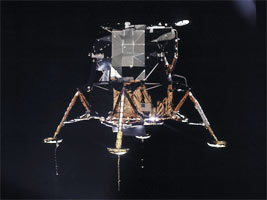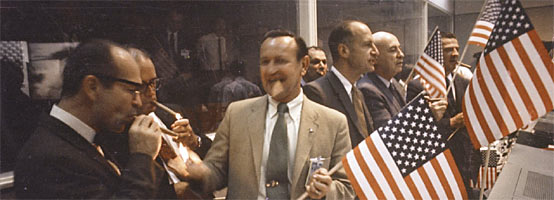
The Apollo 11 Lunar Module (LM), in a lunar
landing configuration, is photographed in lunar orbit
from the Command and Service Modules (CSM). Inside the
LM were astronauts Neil A. Armstrong, commander, and
Edwin E. Aldrin Jr., lunar module pilot. Astronaut
Michael Collins, command module pilot, remained with the
CSM in lunar orbit while Armstrong and Aldrin descended
in the LM to explore the lunar
surface. | When Neil
Armstrong's heart rate rose to 156 as his Eagle Lunar Module
touched down on the moon, there were similar reactions on
Earth as pride, awe and humility struck the hearts of everyone
who had played a part, however small, in the
accomplishment-not to mention the hearts of those millions who
watched the spectacular event unfold on their television sets.
�Houston,
Tranquility Base here. The Eagle has landed,� announced the
flawless lunar landing of Apollo 11 at 3:18 p.m. on July 20,
1969.
Apollo
was a feat of modern technology. The Apollo Lunar Module was
the first true spacecraft designed to fly only in a vacuum,
with no aerodynamic qualities whatsoever. Launched below the
Apollo Command/Service Module on the Saturn booster, it
separated in lunar orbit and descended to the moon with two
astronauts inside. Following the brief stay on the moon and
some extravehicular activity by the astronauts, the Lunar
Module's ascent stage fired its own rocket to rise to the
region where it could dock with the Command/Service Module in
lunar orbit, an unprecedented accomplishment.
In 1961,
when human flights to the moon were being seriously debated,
basic understanding of the undertaking was lacking. Little was
known as to what kind of spacecraft was needed to accomplish
the mission. A ship returning from a lunar voyage faced a much
more difficult injection into the Earth's atmosphere than did
one in Earth orbit. Too shallow an angle and the vehicle might
"skip" off the Earth's atmosphere; too steep an approach would
result in certain incineration. Communications and control
over vastly greater distances than Earth orbit were untested.
The unknown weighed far more heavily than the known. That is
what made the enterprise so challenging and
exciting.

A group
of NASA and Manned Spacecraft Center officials join in with
the flight controllers in the Mission Operations Control Room
in the Mission Control Center, Building 30, in celebrating the
successful conclusion of the Apollo 11 lunar landing mission.
From left foreground are Dr. Maxime A. Faget, MSC Director of
Engineering and Development; George S. Trimble, MSC Deputy
Director; Dr. Christopher C. Kraft Jr., MSC Director of Flight
Operations; Julian Scheer (in back), Assistant Administrator,
Office of Public Affairs, NASA Headquarters; George M. Low,
Manager, Apollo Spacecraft Program, MSC; Dr. Robert R.
Gilruth, MSC Director; and Charles W. Mathews, Deputy
Associate Administrator, Office of Manned Space Flight, NASA
Headquarters.
Gemini
was indispensable in developing the flight control techniques
and procedures necessary for Apollo orbital rendezvous.
Mercury and Gemini flight experiences defined the general
philosophy of the interplay between the MCC in Houston and the
astronauts in the spacecraft and established the flight
interrelationship between the NASA operating teams, hardware
contractors and contractor flight controllers.
Apollo
would go around the moon and out of sight and sound of any
point on the Earth. Those who flew in the Lunar Module, unlike
those who flew in the Mercury, Gemini or Apollo Command
Module, could not return directly to Earth in their
craft. |





